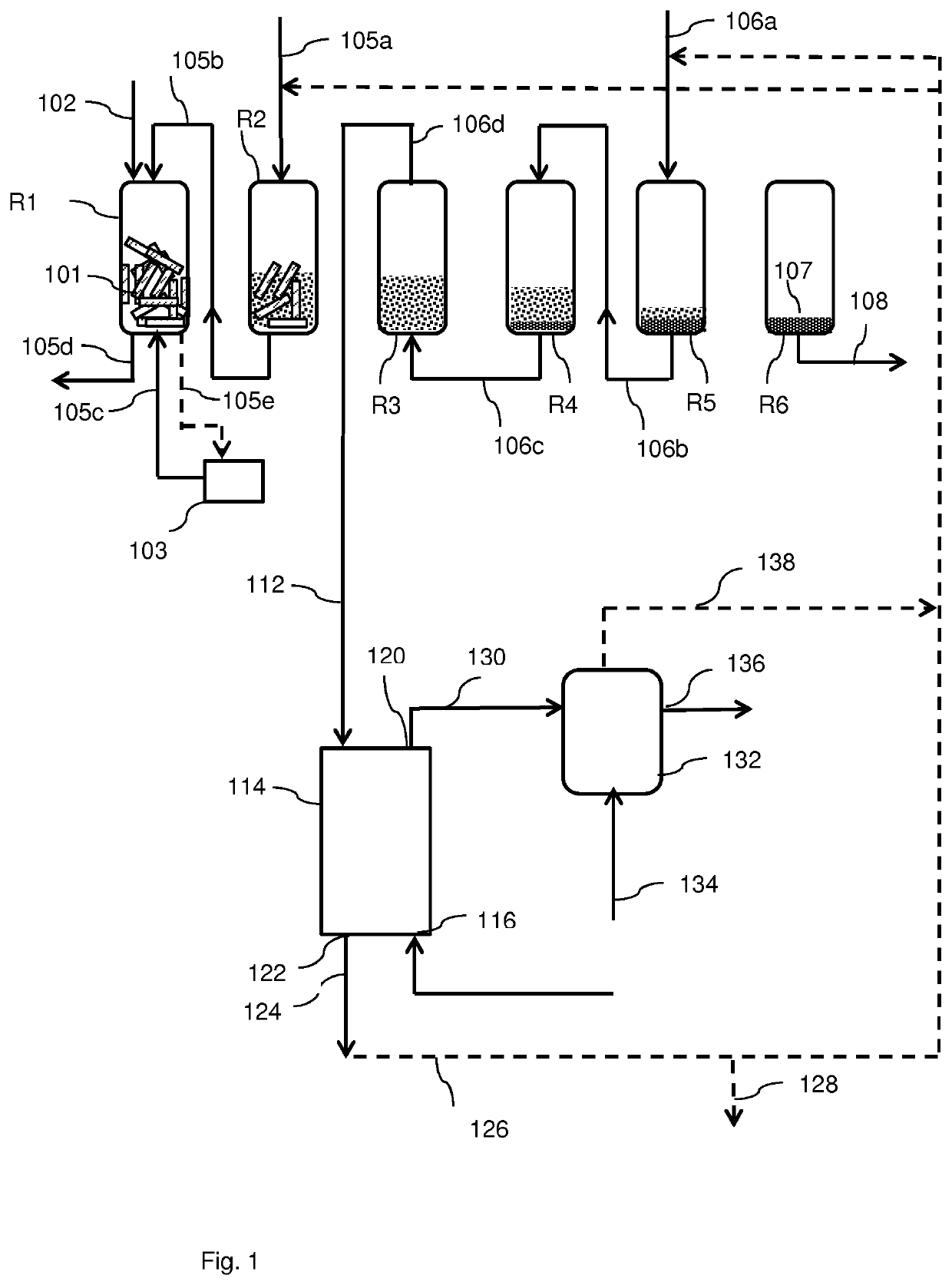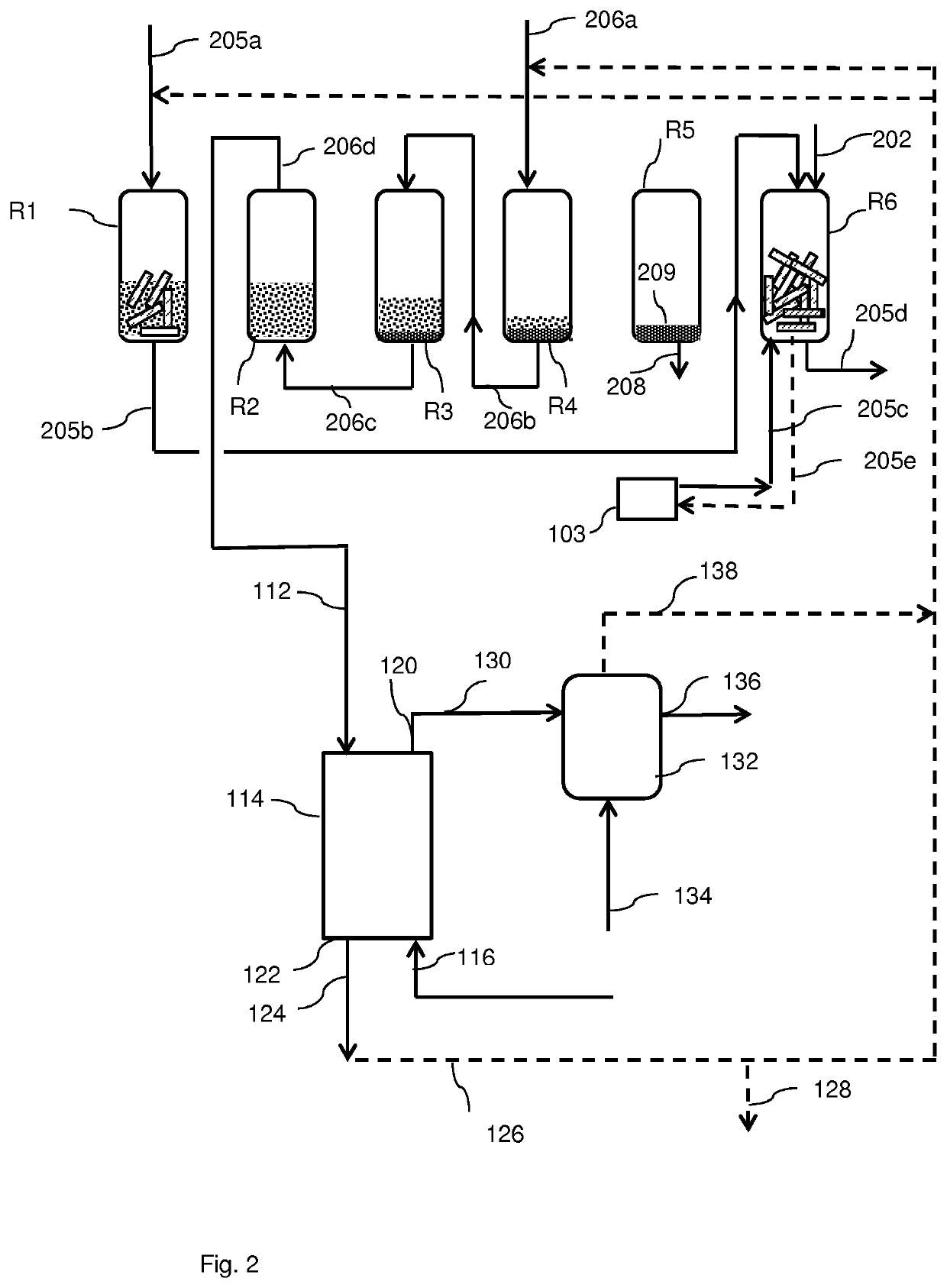Process for the conversion of a solid lignocellulosic material
a technology of solid lignocellulosic material and process, which is applied in the field of process, can solve the problems of cellulose fraction, fraction that may not yield cmf, further, non-profitability, side-products and/or contaminants, etc., and achieves the effects of convenient scaling up, improved use, and flexible flexibility
- Summary
- Abstract
- Description
- Claims
- Application Information
AI Technical Summary
Benefits of technology
Problems solved by technology
Method used
Image
Examples
example 1
[0258]In a first hydrolysis step, hereafter called prehydrolysis step, about 1150 grams of dried pine wood chips, having a particle size as determined by visual inspection of about 4-5 centimeters, was divided over 5 tubular reactors, each tubular reactor having a height of about 60 centimeters and a diameter of about 5.3 centimeters. The pine wood contained about 30.6 wt % cellulose, about 13.7% hemicellulose and about 30.6 wt % lignin, with the remainder being other compounds.
[0259]The pine wood chips were treated with a liquid column of about 8.7 liter of an aqueous solution containing about 37 wt % hydrochloric acid (HCl) in a semi-continuous manner such that in each reactor the pine wood chips were treated for about 16 hours. After treatment the liquid was separated from the remaining solid material by means of a glass filter plate pore size class 0 (i.e. having a nominal pore size of 160-250 μm), resulting in about 5.9 liter of a hydrochloric acid-contai...
example 2
Conversion of Prehydrolysate Product
[0262]A sample of 0.5 ml of the prehydrolysate product obtained in example 1 was combined with 1 ml toluene and loaded in an 8 ml reactor using magnetic stirring at 1600 rounds per minute (rpm). The reaction mixture was heated to 100° C. for 1 hour. Subsequently the reaction was quenched by placing the reactor in ice and separated into a toluene layer and an aqueous layer. The aqueous layer was washed 2 times with 0.5 ml of fresh toluene. Subsequently the toluene layers were combined and analyzed by Gas Chromatography (GC) using dioxane as internal standard, to determine the yields of furfural and 5-(chloromethyl)furfural (CMF). The aqueous layer was analyzed for remaining sugars by ion exchange chromatography and High Performance Liquid Chromatography, (HPLC). The aqueous phase further contained levulinic acid as determined h HPLC.
[0263]The yields of furfural and CMF in weight percentages (wt %), based on the total weight of sugars in the 0.5 ml ...
example 3
Conversion of Main Hydrolysate Product
[0264]A sample of 0.5 ml of the main hydrolysate product obtained in example 1 was combined with 1 ml toluene and loaded in an 8 ml reactor using magnetic stirring at 1600 rounds per minute (rpm). In a manner identical to example 2, the reaction mixture was heated to 100° C. for 1 hour. Subsequently the reaction was quenched by placing the reactor in ice and separated into a toluene layer and an aqueous layer. The aqueous layer was washed 2 times with 0.5 ml of fresh toluene. Subsequently the toluene layers were combined and analyzed by Gas Chromatography (GC) using dioxane as internal standard, to determine the yields of furfural and 5-(chloromethyl)furfural (CMF). The aqueous layer was analyzed for remaining sugars by ion exchange chromatography and HPLC.
[0265]The yields of furfural and CMF in weight percentages (wt %), based on the total weight of sugars in the 0.5 ml sample, were determined and are summarized in Table 2 below.
TABLE 2Furfural...
PUM
| Property | Measurement | Unit |
|---|---|---|
| temperature | aaaaa | aaaaa |
| temperature | aaaaa | aaaaa |
| temperature | aaaaa | aaaaa |
Abstract
Description
Claims
Application Information
 Login to View More
Login to View More - R&D
- Intellectual Property
- Life Sciences
- Materials
- Tech Scout
- Unparalleled Data Quality
- Higher Quality Content
- 60% Fewer Hallucinations
Browse by: Latest US Patents, China's latest patents, Technical Efficacy Thesaurus, Application Domain, Technology Topic, Popular Technical Reports.
© 2025 PatSnap. All rights reserved.Legal|Privacy policy|Modern Slavery Act Transparency Statement|Sitemap|About US| Contact US: help@patsnap.com


